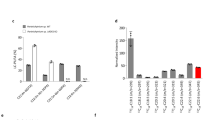Abstract
More than 300 strains of microorganisms producing polyunsaturated fatty acids (PUFA) were newly isolated from coastal seawater in the Seto Inland Sea and around Iriomote Island, Japan, by the baiting method. The profiles of PUFA from docosahexaenoic acid (DHA)-producing strains could be classified into four types. A strain, named KK17-3, was chosen for further study owing to its high DHA content (52.1% of total fatty acid) and wide range of PUFA (76.1%) including arachidonic, eicosapentaenoic, and docosapentaenoic acids as well as DHA. Glucose and tryptone were the optimal carbon and nitrogen sources, respectively, in a medium with salinity at 75% that of seawater. The PUFA contents in polar lipids (22.1% of total lipid), in which the DHA content was 39.3%, were higher than those in neutral lipids and glycolipids. Molecular phylogenetic analysis of 18S rRNA gene sequences showed KK17-3 to be a thraustochytrid. It also was observed to possess a life cycle composed of vegetative cells without successive bipartition, zoosporangium, and zoospore stage. Classification by the chemotaxonomic criterion based on PUFA compositions also supported this assignment.
Similar content being viewed by others
References
Horrobin, D.F., Medical Roles of Metabolites of Precursor EFA, inform 6:428–435 (1995).
Sessler, A.M., and J.M. Ntambi, Polyunsaturated Fatty Acid Regulation of Gene Expression, J. Nutr. 128:923–926 (1998).
Certik, M., and S. Shimizu, Biosynthesis and Regulation of Microbial Polyunsaturated Fatty Acid Production, J. Biosci. Bioeng. 87:1–14 (1999).
Roche, H.M., Unsaturated Fatty Acids, Proc. Nutr. Soc. 58:397–401 (1999).
Horrocks, L.A., and Y.K. Yeo, Health Benefits of Docosahexaenoic Acid (DHA), Pharmacol. Res. 40:211–225 (1999).
Yongmanitchai, W., and O.P. Ward, Omega-3 Fatty Acids: Alternative Sources of Production, Process Biochem. 24:117–125 (1989).
Bajpai, P., P. Bajpai, and O.P. Ward, Production of Docosahexaenoic Acid (DHA) by Thraustochytrium aureum, Appl. Microbiol. Biotechnol. 35:706–710 (1991).
Li, Z.Y., and O.P. Ward, Production of Docosahexaenoic Acid by Thraustochytrium roseum, J. Ind. Microbiol. 13:238–241 (1994).
Bajpai, P.K., P. Bajpai, and O.P. Ward, Optimization of Production of Docosahexaenoic Acid (DHA) by Thraustochytrium aureum ATCC34304, J. Am. Oil Chem. Soc. 68:509–514 (1991).
Kendrick, A., and C. Ratledge, Lipids of Selected Molds Grown for Production of n−3 and n−6 Polyunsaturated Fatty Acids, Lipids 27:15–20 (1992).
Kyle, D.J., Production and Use of a Single Cell Oil Which Is Highly Enriched in Docosahexaenoic Acid, Lipid Technol. 8:107–110 (1996).
Nakahara, T., T. Yokochi, T. Higashihara, S. Tanaka, T. Yaguchi, and D. Honda, Production of Docosahexaenoic and Docosapentaenoic Acids by Schizochytrium sp. Isolated from Yap Islands, J. Am. Oil Chem. Soc. 73:1421–1426 (1996).
Singh, A., S. Wilson, and O.P. Ward, Docosahexaenoic Acid (DHA) Production by Thraustochytrium sp. ATCC20892, J. Microbiol. Biotechnol. 12:76–81 (1996).
Yano, Y., A. Nakayama, H. Saito, and K. Ishihara, Production of Docosahexaenoic Acid by Marine Bacteria Isolated from Deep Sea Fish, Lipids 29:527–528 (1994).
Yokochi, T., D. Honda, T. Higashihara, and T. Nakahara, Classification of DHA-Producing Thraustochytrids by Their Fatty Acid Profile, Proceedings of I.T.I.T. International Symposium on New Technologies from Marine-Sphere, Takamatsu, Japan, 1997, pp. 99–101.
Honda, D., T. Yokochi, T. Nakahara, S. Raghukumar, A. Nakagiri, K. Schaumann, and T. Higashihara, Molecular Phylogeny of Labyrinthulids and Thraustochytrids Based on the Sequencing of 18S Ribosomal RNA Gene, J. Eukaryot. Microbiol. 46:637–647 (1999).
Aki, T., Y. Matsumoto, T. Morinaga, S. Kawamoto, S. Shigeta, K. Ono, and O. Suzuki, Lipid Composition of Newly Isolated Polyunsaturated Fatty Acid Producing Fungus, Achlya sp. ma-2801, J. Ferment. Bioeng. 86:504–507 (1998).
Murray, M.G., and W.F. Thompson, Rapid Isolation of High Molecular Weight Plant DNA, Nucleic Acids Res. 8:4321–4325 (1980).
Thompson, J.D., D.G. Higgins, and T.J. Gibson, Clustal W: Improving the Sensitivity of Progressive Multiple Sequence Alignment Through Sequence Weighting, Position-Specific Gap Penalties and Weight Matrix Choice, Ibid. 22:4673–4680 (1994).
Hasegawa, M., and T. Hashimoto, Ribosomal RNA Trees Misleading? Nature 361:23 (1993).
Saitou, N., and M. Nei, The Neighbor-Joining Method: A New Method for Reconstructing Phylogenetic Trees, Mol. Biol. Evol. 4:406–425 (1987).
Swofford, D.L., Paup *. Phylogenetic Analysis Using Parsimony, Version 4, Sinauer Associates, Sunderland, Massachusetts (1998).
Felsenstein, J., Distance Methods for Inferring Phylogenies: Justification, Evolution 38:16–24 (1984).
Felsenstein, J., Confidence Limits on Phylogenies: An Approach Using the Bootstrap, Ibid. 39:783–791 (1985).
Rema, V., and C. Feng, Eicosapentaenoic Acid and Docosahexaenoic Acid Production of Microalgae and Their Heterotrophic Growth, J. Am. Oil Chem. Soc. 75:393–397 (1998).
Yokochi, T., D. Honda, T. Higashihara, and T. Nakahara, Optimization of Docosahexaenoic Acid Production by Schizochytrium limacinum SR21, Appl. Microbiol. Biotechnol. 49:72–76 (1998).
Iida, I., T. Nakahara, T. Yokochi, Y. Kamisaka, H. Yagi, M. Yamaoka, and O. Suzuki, Improvement of Docosahexaenoic Acid Production in a Culture of Thraustochytrium aureum by Medium Optimization, J. Ferment. Bioeng. 81:76–78 (1996).
Goldstein, S., and M. Belsky, Axenic Culture Studies of a New Marine Phycomycete Possessing an Unusual Type of Asexual Reproduction, Am. J. Bot. 51:72–78 (1964).
Honda, D., T. Yokochi, T. Nakahara, M. Erata, and T. Higashihara, Schizochytrium limacinum sp. nov., a New Thraustochytrid from a Mangrove Area in the West Pacific Ocean, Mycol. Res. 102:439–448 (1998).
Amano, N., Y. Shinmen, K. Akimoto, H. Kawashima, T. Amachi, S. Shimizu, and H. Yamada, Chemotaxonomic Significance of Fatty Acid Composition in the Genus Mortierella (Zygomycetes, Mortierellaceae), Mycotaxonomy 45:257–265 (1992).
Weete, J.D., H. Kim, S.R. Gandhi, Y. Wang, and R. Dute, Lipids and Ultrastructure of Thraustochytrium sp. ATCC26185, Lipids 32:839–845 (1997).
Luthria, D.L., B.S. Mohammed, and H. Sprecher, Regulation of the Biosynthesis of 4,7,10,13,16,19-Docosahexaenoic Acid, J. Biol. Chem. 271:16020–16025 (1996).
Author information
Authors and Affiliations
Corresponding author
About this article
Cite this article
Huang, J., Aki, T., Hachida, K. et al. Profile of polyunsaturated fatty acids produced by Thraustochytrium sp. KK17-3. J Amer Oil Chem Soc 78, 605–610 (2001). https://doi.org/10.1007/s11746-001-0312-1
Received:
Accepted:
Issue Date:
DOI: https://doi.org/10.1007/s11746-001-0312-1




